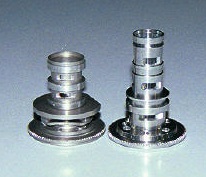Removal of burrs can be one of the costliest secondary processes in a production machining operation. When plastic media blasting (PMB) can do the work, it is usually faster and lower in cost than alternative deburring methods. Here are some suggestions on how to find out if it is right for your situation.
 One of the big pluses for many plastic bead media for deburring applications is that they do not alter the surface texture, finish or appearance of the components. Even parts machined of softer materials, such as aluminum or plastic, can be processed without modifying adjacent surfaces. If, in addition to burr removal, you want to change the finish or improve the looks of the part, there are other media choices that are slightly more aggressive than plastic media that can accomplish both objectives at once.
One of the big pluses for many plastic bead media for deburring applications is that they do not alter the surface texture, finish or appearance of the components. Even parts machined of softer materials, such as aluminum or plastic, can be processed without modifying adjacent surfaces. If, in addition to burr removal, you want to change the finish or improve the looks of the part, there are other media choices that are slightly more aggressive than plastic media that can accomplish both objectives at once.
Impact Treatment
It is helpful to understand how plastic media blasting actually does the deburring work. When hundreds of plastic pellets per second are projected onto the target surface by a blast nozzle at the correct angle and velocity, they deliver a lot of energy, striking the burr many times, and potentially, knocking it cleanly off.
Another point to be mentioned is that resilient plastic beads bounce quite well, rebounding off the surface, and may strike the burr a second and third time, each from a different angle. This characteristic is especially useful for deburring in confined spaces, such as recesses, cross-holes and even some internal features of the component. In some cases, the burr may be “bent” back and forth in a withering action until it breaks off.
Plastic Media for Deburring
A variety of plastic media can be successfully used for deburring applications, including cubical nylon, cylindrical polycarbonate and styrene beads. In some cases, the less fracture resistant plastic grit media may also be effective, but remember that some of the harder grit media like Type III (melamine) and Type V (acrylic) grit may be classified as semi-abrasive materials, and they are capable of producing a frosted finish on aluminum.
Each of these media is available in different screen sizes, and several factors should be evaluated in making a choice. Finer media will have the ability to deliver more impacts per second and do the work faster. Coarser media particles will pack a greater wallop. Always consider the features of the part and the potential for plastic media particles to become
lodged or jammed in small holes or recesses.
Lab Testing Advisable
Guyson always recommends that deburring applications be proven-out in our test laboratory under controlled conditions. It is helpful to compare the results of different blast processes on your own components and avoid making risky assumptions. Detailed test data will be of great value in making decisions about the design of the blast deburring machine.
Because your definitions (or your customer’s) of what is a burr and what is a deburred condition may differ slightly from one another, it is helpful to have examples that everyone agrees are satisfactorily deburred as the starting point for your project.
More Information on Blast Deburring
Contact Guyson if you have questions about deburring with plastic blast media that are specific to your components or processing requirements. Our Customer Service team will also be happy to supply information or a quote on plastic media for your blasting application.
For a broader discussion of blast deburring, including other types of media and special machine features, download our white paper, “Fundamentals of Blast Deburring.” Get White Paper



